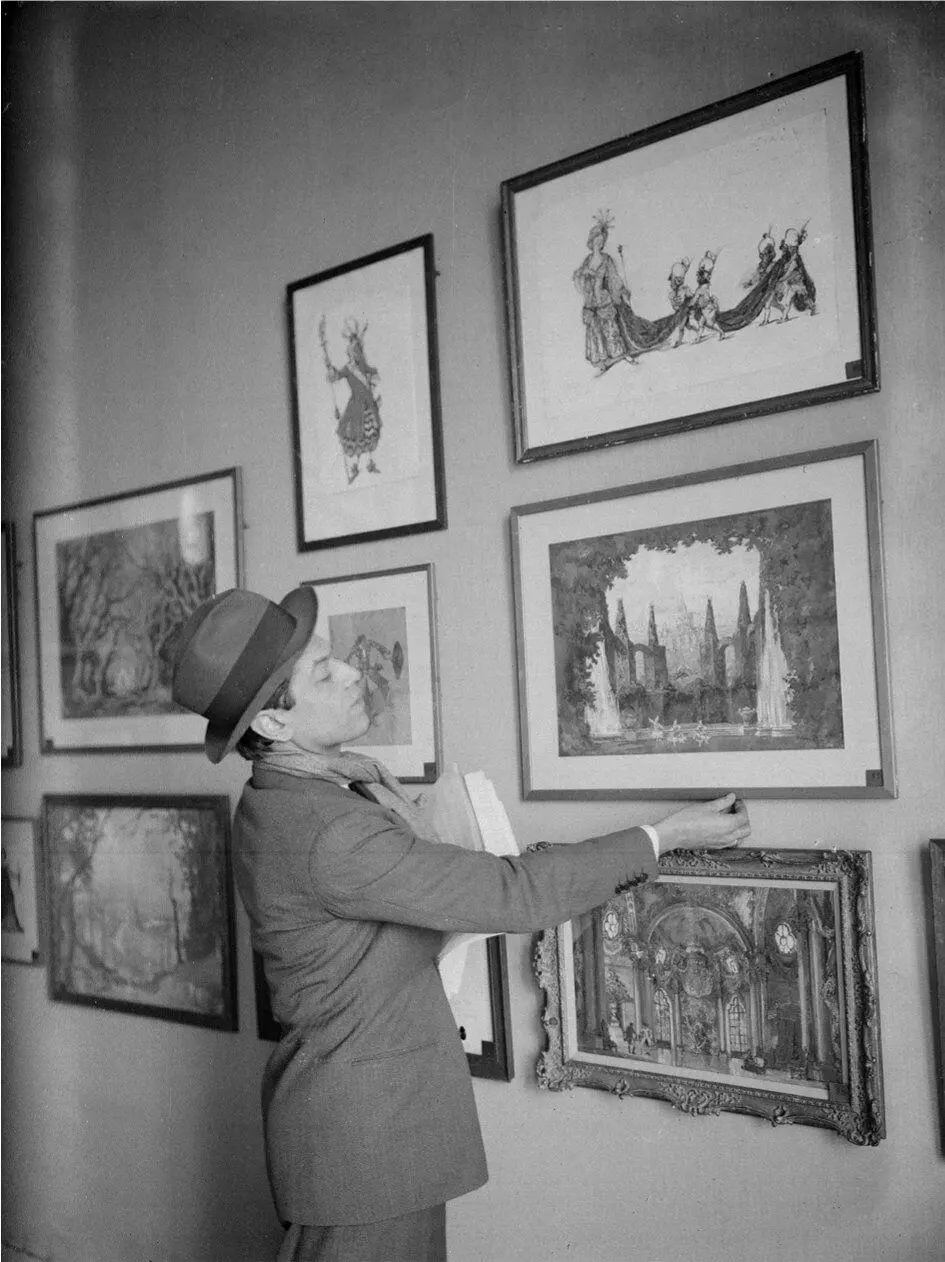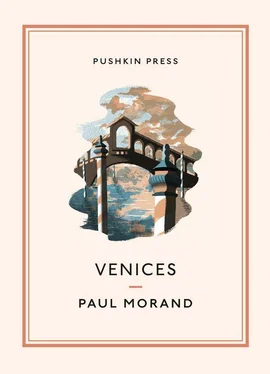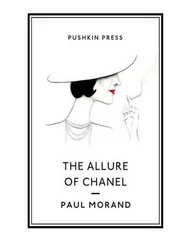Paul Morand - Venices
Здесь есть возможность читать онлайн «Paul Morand - Venices» весь текст электронной книги совершенно бесплатно (целиком полную версию без сокращений). В некоторых случаях можно слушать аудио, скачать через торрент в формате fb2 и присутствует краткое содержание. Год выпуска: 2013, Издательство: Pushkin Collection, Жанр: Современная проза, на английском языке. Описание произведения, (предисловие) а так же отзывы посетителей доступны на портале библиотеки ЛибКат.
- Название:Venices
- Автор:
- Издательство:Pushkin Collection
- Жанр:
- Год:2013
- ISBN:нет данных
- Рейтинг книги:5 / 5. Голосов: 1
-
Избранное:Добавить в избранное
- Отзывы:
-
Ваша оценка:
- 100
- 1
- 2
- 3
- 4
- 5
Venices: краткое содержание, описание и аннотация
Предлагаем к чтению аннотацию, описание, краткое содержание или предисловие (зависит от того, что написал сам автор книги «Venices»). Если вы не нашли необходимую информацию о книге — напишите в комментариях, мы постараемся отыскать её.
Venices — читать онлайн бесплатно полную книгу (весь текст) целиком
Ниже представлен текст книги, разбитый по страницам. Система сохранения места последней прочитанной страницы, позволяет с удобством читать онлайн бесплатно книгу «Venices», без необходимости каждый раз заново искать на чём Вы остановились. Поставьте закладку, и сможете в любой момент перейти на страницу, на которой закончили чтение.
Интервал:
Закладка:
Once the meal was over, each of the guests kept their knives and was required to scrape down the walls in order to search for “Veronese frescoes” beneath the plaster. Had not some been found nearby, at the Villa Magnadola? I can remember José-Maria Sert, sunk into an armchair without springs, his two wives, Misia and Roussy, stretched out at his feet; I can see Diaghilev, a white lock detaching itself from his head of dyed hair, peering at the ceiling through a monocle attached by a ribbon, rather like a figure in Daumier’s engraving Les Amateurs de plafonds, while Serge Lifar and Boris Kochno scraped away at the whitewashed walls. Catherine, mobilising her children as well as her lovers, past, present and future, whom she was skilful enough to make get along together, would proclaim a Veronese with every scrape of the plaster. These invisible frescoes did appear eventually, but they were not painted by the great Paolo, the Sommo Paolo ; they were merely the work of Zelotti and Franco: Aurora’s Chamber and Philemon and Baucis . I came across them again, restored and much as Henri III, the reluctant king, would have seen them on his visit to La Malcontenta on 17 July 1574. This was the occasion for the finest Venetian festival in History; the triumphal arches were painted by Veronese and Titian; since the sumptuary laws had been rescinded for the occasion, patrician ladies and courtesans could be seen, followed by their servants, carrying a hundredweight of their mistresses’ pearls. It was the moment when the Renaissance became the Baroque; in his Histoire de Venise, Daru depicts the king beneath the triumphal arch that Palladio, who was dressed as a Venetian senator, had erected to him. Glassmakers, aboard a raft, are at work at their blowing while the twenty-three-year-old monarch looks on, marvelling at a sea-monster spitting fire through its nostrils.14 Henri III was so impressed by the glassworkers of Murano that he ennobled their corporation and spent a fortune on mirrors and chandeliers; to pay for them, he borrowed one hundred thousand écus from La Serenissima, which caused the Pope to remark: “There go écus that the people of Venice will never see again.” You don’t have to go far to look at this triumphant Henri III; these days he is at the Jacquemart-André museum, having made the journey for you from La Malcontenta to Boulevard Haussmann.
La Malcontenta was home to those dozen or so legendary men and women of whom, Jean-Louis, Lifar and Kochno apart, no one is left;15 they are gone forever, through the simulated doors of the drawing-room. Misia Sert (“When I was twenty, I used to see her at her father, the sculptor Godebski’s house,” my father used to say, “a beautiful panther, imperious, bloodthirsty and frivolous.”), Misia, not the woman who emerges from her flimsy Mémoires , but the one who existed: effervescing with joy or fury, eccentric, acquisitive and a collector of geniuses, all of whom were in love with her: Vuillard, Bonnard, Renoir, Stravinsky, Picasso… a collector of hearts and of Ming trees in pink quartz; whenever her latest fads were launched, they became instantly fashionable among all her followers, and were exploited by designers, written about by journalists and imitated by every empty-headed society lady. Misia, the queen of modern baroque, who organised her life around nacre, pearls and the bizarre; the sullen and deceitful Misia, who would bring together friends who did not know one another “in order to then make them quarrel”, according to Proust. Brilliant in her treachery and subtle in her cruelty, Philippe Berthelot used to say of Misia that one should never entrust her with anything: “Here comes the cat, hide your birds,” he would say whenever she rang the doorbell. In her boutique fantasque on the quai Voltaire, she kindled genius in the same way that certain kings can create victors, by her magnetic presence alone, through an unseen oscillation of a branch of her hazel tree. Misia was as strong as the life-force that smouldered within her; she was mean yet generous, she devoured people in their thousands, she was cajoling, mischievous, subtle, mercenary, even more of a Mme Verdurin than the original one, and she esteemed and despised men and women at a glance. There was the Misia of the Symbolists’ Paris, of Fauvist Paris, First World War Paris, the Paris of the Versailles Peace Treaty, the Paris of Venice. Dissatisfied Misia was as well padded as a sofa, yet if you craved rest, she was a sofa who was likely to send you packing. Misia dissatisfied had piercing eyes which laughed even though her mouth was already beginning to pout.
Where this all-devouring creature was concerned, rapture was followed by disgust, a yes by a no, just as thunder follows lightning; with her, you had to perform quickly.

Serge Lifar at the exhibition celebrating twenty years of the Ballets Russes at the Pavilion de Marsan, 1939
1929
AT THE SLUICE-GATES of Venetian houses you reveal all about yourself the moment you set foot in the doorway. “A slippery city,” D.H. Lawrence said of her. I had arrived there the day after Diaghilev had died. I thought once more about the life of this brilliant impresario whose love of art had been his driving force; he was much more of a sorcerer than an impresario and he had the wizardry of an electro-magnet; his intelligence was not sufficiently developed that it outshone his sense of discovery; his secret derived from the fact that he only ever thought of his own pleasure, requiring the approval of merely a handful of people, such as Picasso, Stravinsky, Lady Ripon, Misia… totally indifferent to the fashions of the day, he never took peeps through the hole in the stage curtain; and he never took a penny on the side. Only his somnambulism can explain his temerity, his inability to foresee obstacles, his crazy improvisations and the way he was blinded to all but his own destiny (the final act of Petrushka was created only ten minutes before the curtain went up at the dress rehearsal).
I reflected on Serge’s career from that moment in 1904 when Prince Volkonsky, the director of the Imperial Theatres, parted with the services of the very young choreographer, criticising him for having staged Sylvia “with too many of his personal ideas”, up until his death in Venice; I thought about his revolutionary yet classical destiny, about this harbourer of monsters, who arrived in Paris and scattered his Muscovite seed there, giving new birth to painting, music, song and dance. I thought of the Ballets Russes which, as a humble soldier arriving by train at the Gare Saint-Lazare, I would watch from the gods at the Châtelet or the Opéra. Diaghilev slips through my past like a stag in the forest; “I caught sight of him,” say the stalkers; but how often did I catch glimpses of Serge! I had known the triumphant Diaghilev from the Châtelet in 1910 to London in 1913, before coming across him, four years later, reduced to poverty (he was never rich) in Spain; impervious to boos and catcalls, he had an Ancien Régime courtesy which storms would occasionally ruffle when some drama or other broke out in the seraglio; beneath the Russian demeanour, the Chinaman was always slumbering… Cosmopolitan in appearance, but Russian in his soul, everywhere he went he recreated that eschatological, Byzantine atmosphere of the eternal Russia; the triumphs, the downfalls, the debts, the harassment, the beloved bodies sewn into sacks and tossed into the Bosphorus; pitting Nijinsky against Fokine, Benoit against Bakst, Lifar against Massine, in a storm of champagne, delirious telegrams, fancy food and dried bread, accompanied by assurances of happiness and threats of suicide, and, finally, his fatal diabetes which was treated with ten dishes that were forbidden him; such was Serge, that tortured executioner. 1929 was not just the year of his death, but a year of wonderful immunity, of a certain freedom about the way one dressed, of the sort of pleasures that were greater than pleasure itself; it marked the end of that wandering chivalry, of that secret intelligence between members of a sect… one that never really existed. Diaghilev was forbidden a residence permit during the First World War; he was even treated suspiciously in the countries that were neutral, up until the moment when he charmed Alfonso XIII, to whom he introduced the young Picasso, who had painted the sets for Parade . In the spring of 1918, we used to lunch together daily at the “Palace” in Madrid; Massine had left him to go to Barcelona to be given lessons in Spanish dancing, and I was the only confidant Diaghilev had; I can still hear him recounting his unbelievable misfortunes; how the Ballets Russes’ costumes and stage sets had been sunk off Cadiz — the sort of wreck that might have occurred in Candide ; how what was saved from the wreckage had been destroyed in a fire in South America; how Clemenceau had barred his entry into France. (Powerless, for once, Misia had been unable to procure a visa for him; Philippe Berthelot was in disgrace and she had not yet won over Mandel.) In 1920, I came across Diaghilev again; he was back in Paris and he had already had time to explore the latest paintings and to have chosen the best of them, never making a mistake and never allowing a source to run dry.
Читать дальшеИнтервал:
Закладка:
Похожие книги на «Venices»
Представляем Вашему вниманию похожие книги на «Venices» списком для выбора. Мы отобрали схожую по названию и смыслу литературу в надежде предоставить читателям больше вариантов отыскать новые, интересные, ещё непрочитанные произведения.
Обсуждение, отзывы о книге «Venices» и просто собственные мнения читателей. Оставьте ваши комментарии, напишите, что Вы думаете о произведении, его смысле или главных героях. Укажите что конкретно понравилось, а что нет, и почему Вы так считаете.












